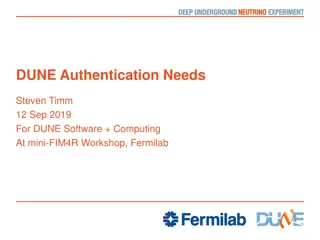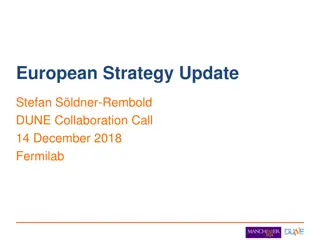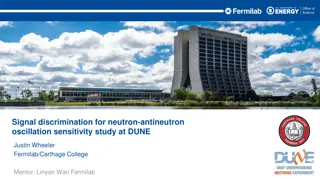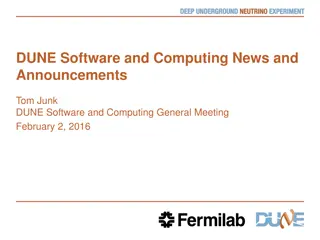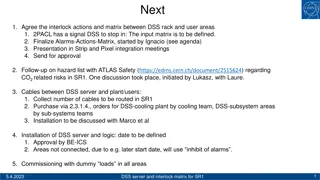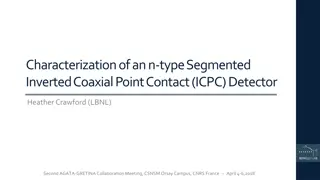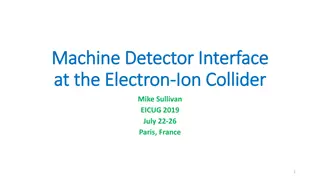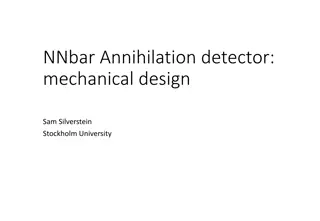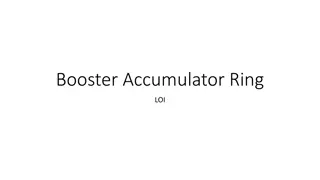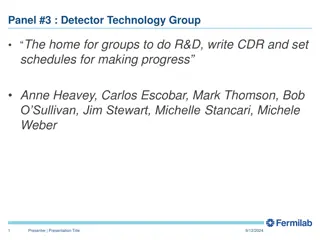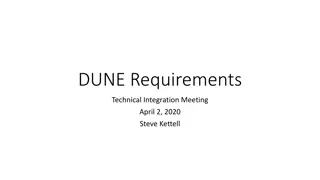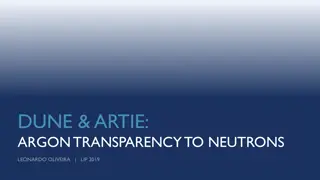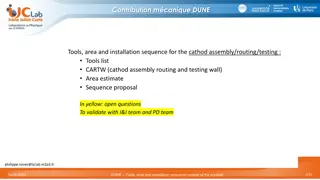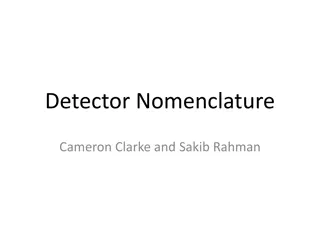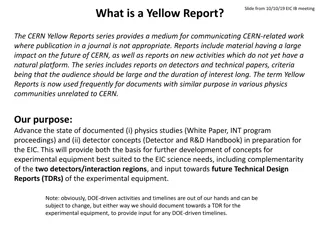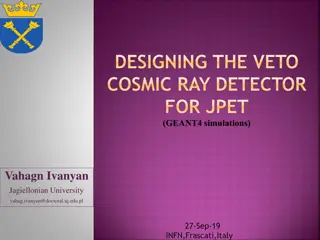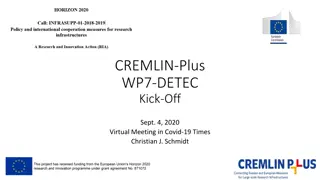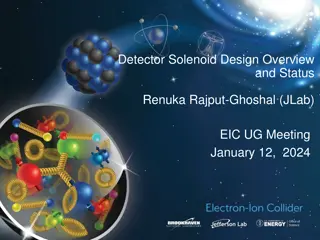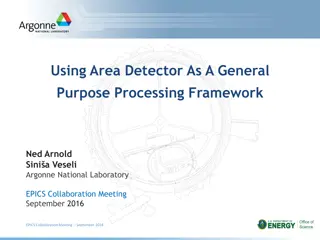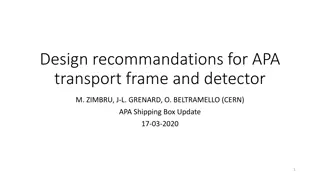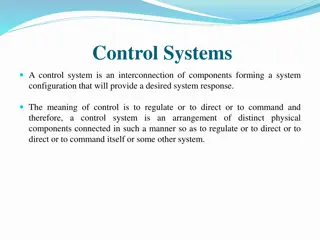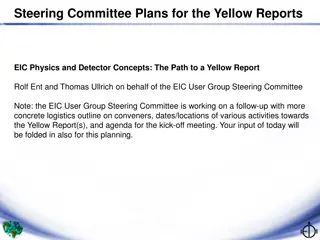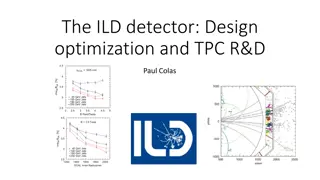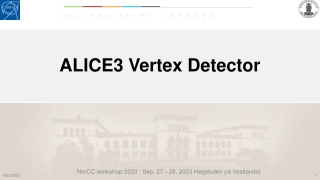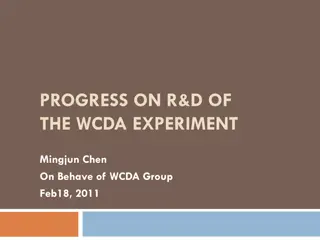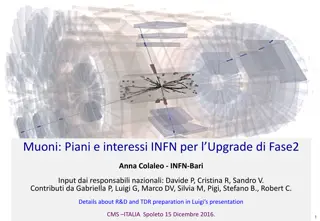DUNE Detector Support System (DSS) Design Review August 20, 2018
This document outlines a review of the DUNE Detector Support System (DSS) design, requesting assessment on various aspects such as meeting requirements, engineering drawings, interfaces with other components, installation scheme, design codes, manufacturing methods, and engineering resources planning. The review seeks a professional evaluation for a final report due by September 1.
Download Presentation

Please find below an Image/Link to download the presentation.
The content on the website is provided AS IS for your information and personal use only. It may not be sold, licensed, or shared on other websites without obtaining consent from the author. Download presentation by click this link. If you encounter any issues during the download, it is possible that the publisher has removed the file from their server.
E N D
Presentation Transcript
DUNE DSS Review August 20 2018 THANK YOU for helping us to review the design of the DUNE Detector Support System (DSS)
Charge The committee is requested to review the DUNE detector support structure (DSS) design and determine if it meets the requirements of the conceptual design (30% design) as outlined in the DUNE Far Detector Design Review Plan (DocDB-9564). As reference, report for final design review of Proto-DUNE DSS is available in DocDB-1584. Specifically: Does the design address the requirements in accordance with detector requirements: installation, positional tolerance, cool down, load capacity, grounding, testing and alignment? Do preliminary engineering drawings, schematics and models provide sufficient information to ascertain constructability, installability and functionality? Have interfaces with other detector components been identified and addressed? Are the interfaces with the cryostat and the TPC well defined and understood? Are preliminary engineering analyses and documentation sufficient to ensure the design is on the right track? Does the DSS present a reasonable scheme for installation of detector elements, and are similarities and differences to ProtoDUNE taken into account? Have applicable design codes and standards been identified and are they appropriate? Have appropriate manufacturing methods been identified and rough cost estimates and schedule been determined? Are plans for required engineering resources consistent with scope of work?
This is an internal DUNE review. We would like your honest and professional evaluation of the state of the DUNE DSS conceptual design. We would appreciate your assessment of each of the charge questions. We request your findings, comments and recommendations in a closeout tomorrow and a final written report by September 1.
1 INTRODUCTION ......................................................................................................... 3 2 TECHNICAL EVALUATION ...................................................................................... 3 2.1 Requirements ................................................................................................................................................................. 3 2.2 Design standards ........................................................................................................................................................... 3 2.3 Engineering analysis .................................................................................................................................................... 3 2.4 Scope ................................................................................................................................................................................ 3 3 SUMMARY AND RECOMMENDATIONS ................................................................. 3 4 APPENDICES ............................................................................................................... 4 4.1 Review Website and Agenda .................................................................................................................................. 4 4.2 Committee Members ................................................................................................................................................. 4 4.3 Applicable Documents .............................................................................................................................................. 4 4.4 Answers to Review Charge Questions ................................................................................................................. 4 4.5 References ..................................................................................................................................................................... 4
1Introduction This document is the report of the Conceptual Design review of the Single-Phase Detector Support System that was held 20 21 August 2018 at CERN. This review is part of the DUNE Far Detector Design Review Plan (DocDB-9564). The committee congratulates the design team on all of the work involved in preparing for this review. Overall the committee found The committee recommends 2Technical Evaluation 2.1 Requirements (Farshid, Dan) Evaluation of how the design meets detector requirements and are interfaces properly addressed 2.2 Design standards (Olga, Dan) Evaluation of design standards and design codes 2.3 Engineering analysis (Dimitar, Peter, Dan) Evaluation of engineering analyses, manufacturability, installation scheme and functionality 2.4 Scope (Steve, Farshid, Peter) Evaluation of cost, schedule, and scope 3Answers to Review Charge Questions Each subcommittee
Type SystemQuantity/Parameter Requirement Explanation Comments Allowing gaps to open up between some APAs will reduce the overall shrinkage of the detector. Also simplifies construction and installation of the detector support structure. DSS should provide support such that the APA, CPA and FC can maintain rectangular parallelepiped under LAr conditions. Specifically the rails should remain parallel to each other at a fixed distance throughout the detector volume Notes ProtoDUNE Validation DSS Requirements DSS gaps between APAs <20mm Loss of fiducial volume or distortion of charge collection near APA gaps should be minimized. Use of electron diverters should minimize impact based on simulation. Current conceptual design has 17mm gaps between each grouping of three APAs Effect of gaps between APAs (and effectiveness of installed electron diverters) on track reconstruction will be studied using the ProtoDUNE data. 1 Scientific Space charge in ProtoDUNE will complicate the analysis of the field uniformity. Local effects close to the field cage electrodes could be in principle be disentagled, exploiting through-going muon tracks. <1% throughout volume Misalignments of the various TPC components should not introduce drift field non-uniformities beyond those specified in the HVS requirements 2 Scientific DSS drift field uniformity Minimum electric field requirement is based on the minimum drift field goal of 500 V/cm. In order to reach the desired drift fields, the integrated detector design needs to minimize potential pathways for HV discharges. HV discharges limit detector livetime and have the potential for damaging detector components. engineering high level 3 Global local electric fields <30 kV/cm Expectation is that system noise will be dominated by random noise on the front-end. All other noise contributions must be much lower than the targeted noise level for the collection wires. Rules established by the grounding and shielding committee that must be followed by all detector sub-systems. engineering high level 4 Global noise contributions << 500 enc All materials used in fabrication of detector components that go inside of cryostat must be tested. Need to define requirements for screening of the materials used to fabricate detector components. No detector components should significantly increase the nominal level of contamination within the liquid argon through outgassing or other processes. Gas purging is required at the top of the cryostat to prevent contaminates from entering the liquid volume. engineering high level 5 Global LAr impurity contributions << 30 ppT Introduced radioactivity should be less than that from 39Ar Materials used in construction of detector components should not significantly increase the radiological background beyond nominal levels. engineering high level Cryostat and cleanroom are planned to be maintained as class 100,000. 6 Global radiopurity The DSS must support the weight of the detector, with all of its elements Must meet appropriate structural design codes per site requirements. 7 engineering DSS weight >135 tons TCO size as designed in cryostat design The DSS and all detector components must allow for installation through the TCO 8 engineering DSS install through TCO The DSS must allow for all detector elements to be installed in the correct locations. The DSS must transport all detector elements to their final locations. DSS must accommodate installation of cables and cable supports. DSS feedthrough locations must be compatible with cryostat warm structure. Per detector element, e.g. with APA yoke or CPA support plate Compatibility with detector elements and installation 9 engineering DSS Maintain detector location at LAr temperature. Maintain detector location during cryostat roof movement during filling, testing, and operation and for feedthrough alignment/location tolerance No absolute number is required for physics. The requirement is driven by engineering to ensure no damage occurs. Accommodate shrinkage of the detector and DSS itself. DSS must accommodate variation of feedthrough locations and cryostat deformation. 10 engineering DSS
Questions? Any concerns on the agenda? Do we want to ask questions during the talk? or at end? Writing assignments are clear? Clarifications needed on any documents?





